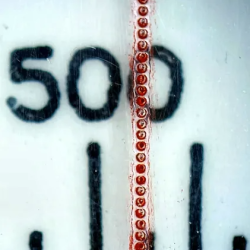When is a line not a line? When it’s a series of tiny dots, of course!

That’s the technique [Ed Nisley] used to create a super-fine, colored hairline in a piece of clear plastic — all part of his project to re-create a classic Tektronix analog calculator from the 1960s, but more on that in a moment.
[Ed] tried a variety of methods and techniques, including laser engraving a solid line, and milling a line with an extremely tiny v-tool. Results were serviceable, but what really did the trick was a series of tiny laser-etched craters filled in with a red marker. That resulted in what appears — to the naked eye — as an extremely fine hairline. But when magnified, as shown here, one can see it is really a series of small craters. The color comes from coloring in the line with a red marker, then wiping the excess off with some alcohol. The remaining pigment sitting in the craters gives just the right amount of color.
This is all part of [Ed]’s efforts to re-create the Tektronix Circuit Computer, a circular slide rule capable of calculating all kinds of useful electrical engineering-related things. And if you find yourself looking to design and build your own circular slide rule from scratch? We have you covered.
















Photoresist, point source light, colimating lens – Bob’s your auntie.
Or the good old scribe, drawn along a straightedge. Never underestimate the utility of a nice Pointed stick!
while I agree with the sentiment that there are much simpler and/or cheaper methods for making a nice colored line in clear plastic in general, you can also use the laser cutter to cut out the plastic cursor piece at the same time. So under the circumstances this is quite possibly the simplest method (add an additional dotted cut line).
.. and yes, I know there are also much cheaper ways to cut out a piece of thin plastic too (hot wire, careful use of a jigsaw, tabletop CNC router, maybe even scissors or a razorblade if it’s thin enough…)
Also, making the cutting and engraving in a single operation result in higher precision
Except for the point where the scribe or blade actually makes a finer line than .15 mm and doesn’t result in uneven melting at the edges.
Putting a good-looking hairline on a good-looking cursor is a major challenge, because there’s nowhere to hide the blunders: you look right at the hairline.
I just discovered pushing Lightburn’s dot mode to an unreasonable limit carves a continuous trench (no dots‽) and fuses the protective film to the edges. Scribble crayon into the trench, pull off the film, and the hairline comes out just about perfect:
https://softsolder.com/2022/05/31/homage-tektronix-circuit-computer-laser-engraved-hairline-improvement/
Outstanding work. It is surprisingly difficult to make a fine line like this and have it look ‘right’ . I will keep this idea in my back pocket!
This tool looks useful!
Since I don’t own a plotter, aren’t there somewhere to download straight PNG images for a regular laser printer?